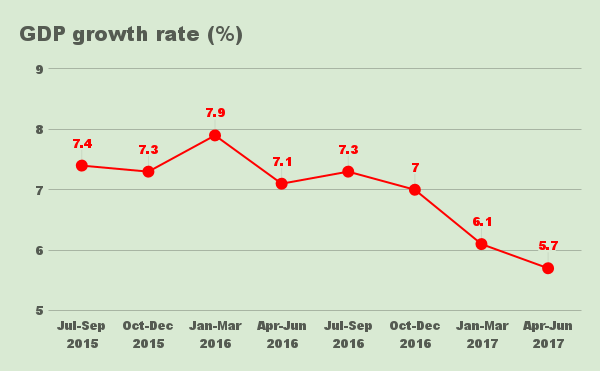India’s GDP growth at 5.7% in the first quarter did not come as a surprise as the country was still reeling under the self-imposed noteban and massive destocking ahead of an ambitious switch to the indirect tax regime of Goods and Services Tax (GST). The scenario, however, has improved since then, and so is expected for the GDP growth — between 6.2% and 6.6% by conservative estimates. The Reuters poll of 52 economists has estimated the GDP growth at 6.4% from a year ago. If the GDP data matches estimates, it will break a five-quarter slowing trend and mark the best rate this calendar year.
As India’s second quarter (July-September) GDP data is expected to be announced on Thursday, here are three things that may have played a crucial role:
Impact of Goods and Services Tax




The second quarter GSP data is going to record the impact of the GST on the economy for the first time since its implementation. Industry body FICCI estimated a GDP growth at 6.2 % saying that the country seems to be stabilising under the GST. “The slowdown in the economy due to demonetisation and the adjustment impact of GST implementation seems to be bottoming out and as the new indirect tax regime stabilises, the economy would see an improvement in its performance,” it said in its Economic Outlook Survey.

Gross Value Addition
GVA is the total value of goods and services produced in the economy after deducting the cost of inputs and raw materials. In the first quarter of the current fiscal year, the Gross Value Addition had plummeted to 1.2% from 10.7% in the same quarter a year ago, leading to a lower GDP growth. In the second quarter, it is expected that there would be a recovery in manufacturing too. Industrial and manufacturing activity as measured by business surveys has also improved in recent months.
According to credit rating agency Icra, the economic growth, as per the Gross Value Added (GVA) calculation, would record a sequential recovery to 6.3 percent in the second quarter led by a broad-based pick up in industrial growth.
Inflation and Festival Season
The annual consumer inflation has hit a seven-month high of 3.6 percent in October. Oil prices and those of other commodities have risen in recent months but the festival season may turn out to be the saviour. “Growth was probably cushioned by festive demand, and an uptick in industrial production,” he said, referring to the national holiday of Diwali in mid-October,” wrote Shashank Mendiratta, an economist at ANZ.
Since mid-year, sales of two-wheel and commercial vehicles, oil consumption, cargo traffic and rail freight have all increased and raised hopes that the impact of the cash squeeze has bottomed out.




















